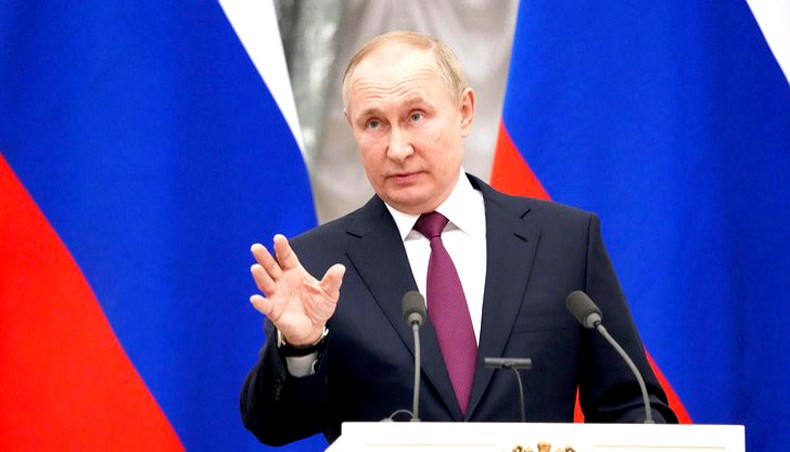
THE Ukraine war is into its fifth month with little sign of change. It is now evident that neither side can lose, and neither side can win.
Take Russia first. In the unlikely event that president Vladimir Putin made rapid progress, the North Atlantic Treaty Organisation would quickly redouble its efforts to ensure that Ukraine did not fall, whatever that took in weapons, equipment or financial aid. The Pentagon may say that its uniformed military has withdrawn, but it has forces across Europe involved in training the Ukrainian military, some just across the border from Ukraine.
The US Central Intelligence Agency, meanwhile, is heavily involved inside Ukraine, supplying plenty of on-the-spot training, and intelligence support. Commandos from other NATO countries, including the United Kingdom, Canada, France and Lithuania, are moving in and out of Ukraine to conduct a range of tasks, which can be easily increased.
It all means that this is very much a proxy war. NATO cannot conceive of losing, because then it would lose its credibility. Instead, the alliance is increasing its alert forces from 40,000 to over 300,000, including thousands more US troops being posted to Europe.
Many NATO states have already announced military budget increases. For some, British prime minister Boris Johnson among them, doing so is a political necessity.
Johnson is in dire need of support from the Conservatives, who happen to love anything military. He talks excitedly of a 25 per cent increase in the defence budget, with ‘tens of billions’ of pounds more being spent over the next few years. Awkwardly for him, the UK Treasury is determined to control military spending — not least because Britain’s version of the military-industrial complex is appallingly wasteful.
Keeping western publics on side
SO WHAT of Russia’s response if it is forced onto the defensive? It is here that peering through the smoke and mirrors is far from easy.
Ukraine, understandably enough, sees little option but to publicise the worst-case scenarios as it must have maximum support from NATO. Keeping western publics on its side is essential, and the country’s president Volodymyr Zelensky has been unexpectedly good at this, no doubt much to Putin’s annoyance.
Russia is presented as having formidable forces encroaching on territory in Donbas, with seemingly little to stop them. The loss of civilian and military life, as well as the damage being caused to the country, is truly appalling. It may even exceed the destruction visited on Yemen earlier this year by the Saudi and Emirati forces that were backed by the UK, the US, and other NATO members. That is not discussed in polite circles, especially in the western mainstream media, but then the destruction in Afghanistan, Iraq and Libya is also conveniently forgotten.
Russia’s path in the coming weeks will include further attempts to take territory while launching salvos of ballistic and cruise missiles at Ukraine’s urban areas. The latest example of these stand-off attacks is the double missile twin attack on Odessa in the early hours of last Friday that has killed at least 18 people in an apartment building and a recreation centre. These attacks are aimed at reminding Ukraine where the power still lies but are having the reverse effect of reminding the wider public of the need to support Ukraine.
As for the ground troops, they may outnumber their Ukrainian opponents, but their morale is much lower, not least because of the tens of thousands killed and maimed and the huge losses of weapons and equipment. The army is making some progress in Donbas, but it is very slow and suffering many more casualties.
It may still have some advantages, primarily with long-range artillery for use on the battlefield, and air-launched missiles for hitting Ukrainian cities, but the United States and other NATO members are already addressing these. The HIMARS multiple-launch rocket system, for example, is superior to anything that the Russian army has in terms of range and accuracy, and is already having an impact on the battlefield. That, and new long-range howitzers, are likely to slow down Russia.
As for the missiles, on Monday last week, US national security adviser Jake Sullivan announced ‘an upcoming security assistance package to Ukraine’ that is specifically designed to address that issue. It is likely to include ground-based anti-missile missile systems and possibly advanced missiles and radars for interceptor aircraft.
These developments could essentially stop and even reverse Russia’s recent progress, and they come at a time when it is already facing problems elsewhere. Russia’s withdrawal from the strategically significant Snake Island has been much reported but it has been far less noted that the Ukrainian army is making gains in other areas, most notably around Kherson in the south. Putin’s forces may be concentrating on Donbas but it is starting to look like they cannot, at the same time, hold all the territory they control elsewhere.
Earlier this week, Putin made his first foreign visit since the invasion began in February, by attending a gathering of Central Asian heads of state, including the oil-rich Kazakhstan and Iran, in Turkmenistan. He looked relaxed and confident, as though all was going to plan in Ukraine.
This stance appears increasingly delusional, and the Russian predicament is likely to intensify in the coming weeks. Given Russia’s large arsenal of weapons of mass destruction, it is then that the danger of escalation will really come to the fore. Putin has everything to lose in Ukraine and NATO leaders should remember that.
OpenDemocracy.net, June 4. Paul Rogers is emeritus professor of peace studies in the department of peace studies and international relations at Bradford University and an honorary fellow at the Joint Service Command and Staff College. He is openDemocracy’s international security correspondent.
